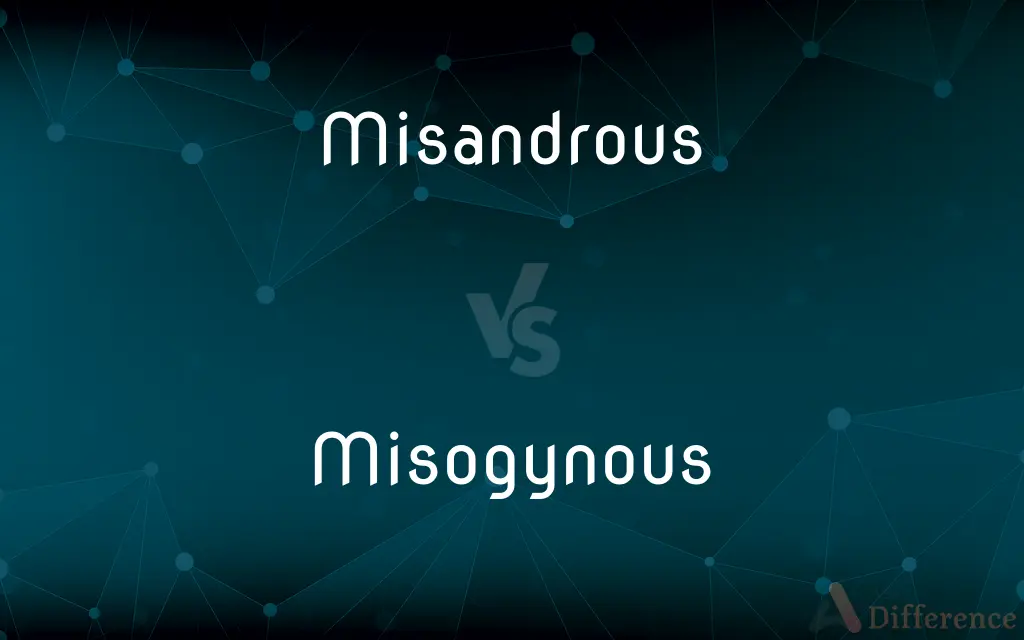Misandrous vs. Misogynous — What's the Difference?
Edited by Tayyaba Rehman — By Urooj Arif — Updated on April 24, 2024
Misandrous pertains to the hatred of men, focusing on bias against males, while misogynous describes hatred towards women, emphasizing gender-based animosity.

Difference Between Misandrous and Misogynous
Table of Contents
ADVERTISEMENT
Key Differences
Misandrous reflects attitudes or behaviors that exhibit hatred or prejudice against men, often manifesting in social or cultural practices. On the other hand, misogynous attitudes are directed towards women, frequently influencing societal norms and personal interactions.
In literature, misandrous themes might explore scenarios where male characters face systemic discrimination, whereas misogynous narratives often depict female characters struggling against oppression and marginalization.
Media portrayal often amplifies misandrous content by showcasing male characters as inherently flawed or villainous, while misogynous content tends to demean or objectify women, reinforcing harmful stereotypes.
Legal frameworks can sometimes address misandrous practices by implementing policies aimed at protecting men's rights, particularly in areas like family law or workplace equality. Conversely, misogynous practices are often countered through legislation focused on women’s rights, such as anti-discrimination laws and protections against gender-based violence.
In the context of social movements, misandrous ideologies might drive certain feminist or gender-critical factions that criticize patriarchal structures while blaming men collectively. On the other side, misogynous views are typically held by those who oppose feminist ideals, often perpetuating traditional gender roles.
ADVERTISEMENT
Comparison Chart
Definition
Hatred or prejudice against men
Hatred or prejudice against women
Common in
Certain radical feminist or men's rights movements
Traditional patriarchal societies
Impact on Society
Can influence legal and social structures negatively
Often leads to gender discrimination and violence
Media Representation
Men portrayed negatively or as lesser
Women often shown in stereotypical or demeaning roles
Legal Response
Lesser focus in law compared to misogynous actions
More established legal frameworks for protection
Compare with Definitions
Misandrous
Advocating for the exclusion of men.
The policy was criticized for its misandrous implications.
Misogynous
Advocating for the exclusion of women.
The club’s membership rules were unmistakably misogynous.
Misandrous
Biased against men in practice or attitude.
The hiring practices at the company were subtly misandrous.
Misogynous
Exhibiting hatred towards women.
His misogynous comments were met with immediate backlash.
Misandrous
Believing that men are inferior.
The novel's misandrous themes sparked widespread debate.
Misogynous
Believing that women are inferior.
The organization faced accusations of harboring misogynous beliefs.
Misandrous
Exhibiting hatred towards men.
The group's misandrous rhetoric alienated potential allies.
Misogynous
Biased against women in practice or attitude.
The jury's verdict was influenced by misogynous stereotypes.
Misandrous
Promoting male stereotypes negatively.
The film was criticized for its misandrous portrayal of the male protagonist.
Misogynous
Promoting female stereotypes negatively.
The advertising campaign was pulled for its misogynous content.
Misandrous
Exhibiting or pertaining to misandry: hating or prejudiced against men.
Misogynous
One who hates or mistrusts women.
Misogynous
Of, relating to, or exhibiting misogyny; misogynistic.
Misogynous
Hating women; having deep-seated distrust of women; - used of men.
Misogynous
Hating women in particular
Common Curiosities
What are common misconceptions about misandry?
A common misconception is that misandry is simply a reaction to misogyny and thus less harmful, overlooking its potential to independently perpetuate gender bias.
How do misogynous attitudes impact relationships?
Misogynous attitudes can lead to unequal power dynamics in relationships, often resulting in emotional abuse or control over women by men.
What societal factors contribute to misandrous beliefs?
Societal factors like historical grievances, certain radical ideologies, and perceived threats to gender equality can contribute to misandrous beliefs.
How do misandrous attitudes impact relationships?
Misandrous attitudes can strain interpersonal relationships, creating distrust and conflict between genders, especially affecting romantic and professional interactions.
What legal measures can combat misandrous practices?
Legal measures such as equality-focused legislation, anti-discrimination laws, and educational reforms can help combat misandrous practices.
What societal factors contribute to misogynous beliefs?
Cultural traditions, patriarchal societal structures, and longstanding gender roles often contribute to the development of misogynous beliefs.
How does misandry differ from feminism?
Misandry involves prejudice or disdain towards men and is often mistakenly associated with feminism, which actually advocates for gender equality and not the superiority of any gender.
What are common misconceptions about misogyny?
A misconception about misogyny is that it only involves overt hatred or violence against women, ignoring more subtle forms like systemic discrimination and belittling.
How do misandrous and misogynous attitudes affect workplace dynamics?
These attitudes can lead to hostile work environments, hinder career progression for the targeted gender, and impact overall workplace morale and productivity.
How do media portrayals contribute to misandrous perceptions?
Media can contribute to misandrous perceptions by consistently depicting men in negative roles, such as perpetrators of violence or as inherently incompetent.
Can misandrous and misogynous attitudes coexist in the same society?
Yes, both attitudes can coexist within the same society, often influenced by complex social dynamics and conflicting ideological perspectives.
What legal measures can combat misogynous practices?
Strengthening laws against gender-based violence, enforcing equal pay regulations, and enhancing legal protections in the workplace are crucial measures against misogynous practices.
What role do social movements play in addressing misandry and misogyny?
Social movements are pivotal in raising awareness, advocating for legal changes, and shifting public perceptions regarding both misandry and misogyny.
How does education influence misandrous and misogynous attitudes?
Education plays a critical role by either challenging or reinforcing these attitudes through curriculum, societal discourse, and the school environment.
Share Your Discovery

Previous Comparison
Shrank vs. Shrunk
Next Comparison
Yes vs. SureAuthor Spotlight
Written by
Urooj ArifUrooj is a skilled content writer at Ask Difference, known for her exceptional ability to simplify complex topics into engaging and informative content. With a passion for research and a flair for clear, concise writing, she consistently delivers articles that resonate with our diverse audience.
Edited by
Tayyaba RehmanTayyaba Rehman is a distinguished writer, currently serving as a primary contributor to askdifference.com. As a researcher in semantics and etymology, Tayyaba's passion for the complexity of languages and their distinctions has found a perfect home on the platform. Tayyaba delves into the intricacies of language, distinguishing between commonly confused words and phrases, thereby providing clarity for readers worldwide.













































